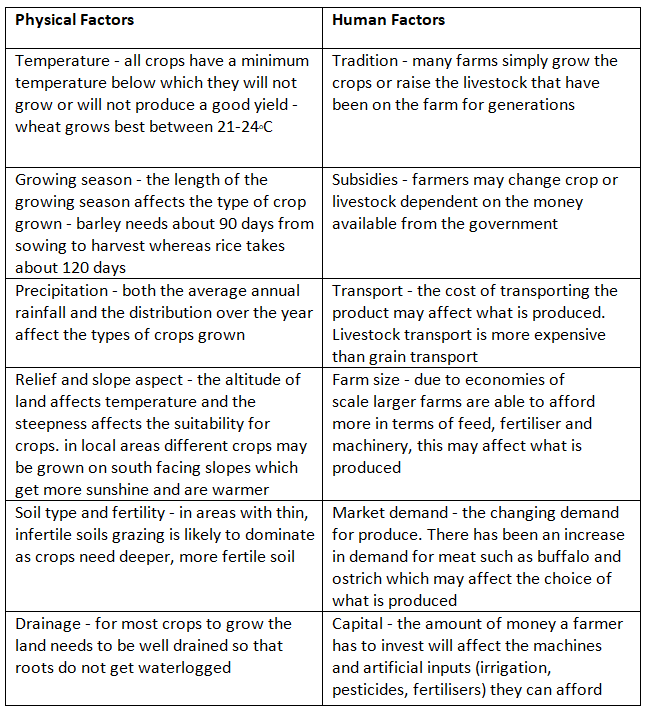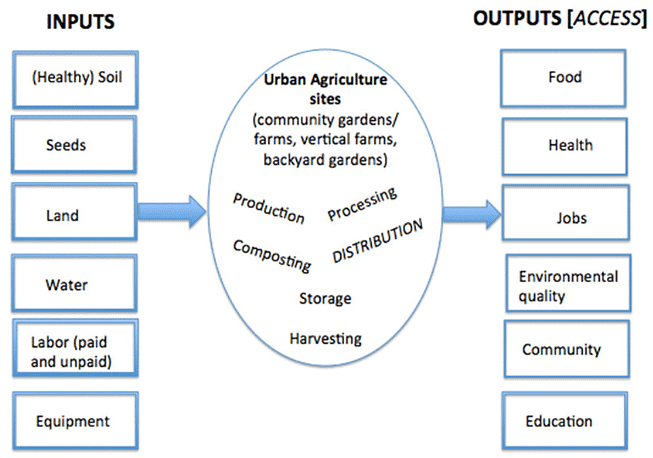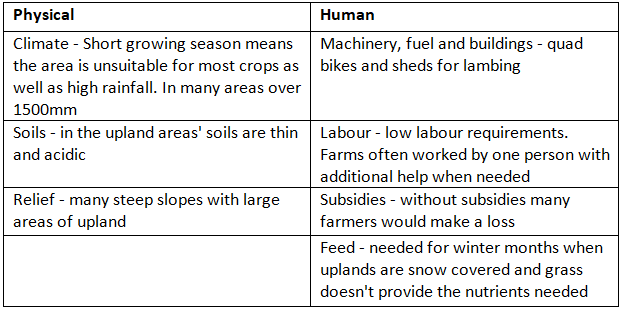Class 10 Exam > Class 10 Notes > Geography for GCSE/IGCSE > Agricultural Systems
Agricultural Systems | Geography for GCSE/IGCSE - Class 10 PDF Download
| Table of contents |

|
| Agricultural Systems |

|
| Factors influencing the type of agriculture |

|
| Understanding Farming Systems as Ecosystems |

|
| Case Study: Sheep Farming |

|
Agricultural Systems
- To acquire food, humans modify ecosystems through farming.
- Farming is categorized into four groups:
- Arable and pastoral
- Commercial and subsistence
- Extensive and intensive
- Nomadic and sedentary
- A mixed farm combines livestock and crop cultivation.
Factors influencing the type of agriculture

Question for Agricultural SystemsTry yourself: What are the two types of farming categorized based on their purpose?View Solution
Understanding Farming Systems as Ecosystems
- All farms function as systems, comprising inputs, processes, and outputs.
A Farming System

A Farming System's Impact on the Ecosystem
- Farming systems interact with the environment they are situated in, influencing it in various ways.
- Some systems have more significant impacts, such as monocultures that limit biodiversity.
- When nutrient cycles rely heavily on external inputs like fertilizers, it can disrupt natural processes.
- Modifications to the ecosystem through the use of seeds, fertilizers, pesticides, and machines can alter natural balances.
- Reduced food webs and biomass levels are common outcomes of intensive farming practices.
Case Study: Sheep Farming
- The topography of the land in Cumbria restricts the types of farming activities possible.
- Low-lying regions are primarily utilized for cattle grazing and growing limited crops.
- Sheep rearing is the predominant agricultural activity, with around 3 million sheep raised in the region.
- This form of farming exemplifies extensive, commercial, pastoral, and sedentary practices.
Land Use Zones on Sheep Farms
- The Fell: These elevated areas above 300 meters serve as grazing grounds for the livestock.
- The Intake: Lower slopes that are partitioned into fields for various purposes.
- The Inbye: Proximity to farm structures, used for lambing, shearing activities, and sometimes cultivating crops like turnips and hay for livestock feed.
Classification of Inputs
- Inputs on a hill sheep farm can be categorized into physical and human resources.

Essential Processes on a Hill Sheep Farm
- Monitoring the Sheep: Keeping a close eye on the health and well-being of the flock.
- Lambing: The birthing process for ewes.
- Dipping: A practice employed to combat parasites and maggots.
- Shearing: Removing wool from sheep, typically done annually.
End Products of Farming
- Lambs: Young sheep raised for meat, usually slaughtered before reaching a year of age (around 6-8 months).
- Wool: Harvested from shearing, its value can sometimes exceed the returns from selling the fleece.
- Mutton: Meat sourced from mature sheep, typically over a year old.
Challenges
- Hill Sheep Farming Challenges: Profitability issues often lead farmers to depend on subsidies or diversification for income.
- Subsidies and Diversification: Farmers rely on subsidies or diversification due to the unprofitability of hill sheep farming.
- Disease Outbreaks: In 2001, foot and mouth disease led to the culling of nearly 500,000 sheep to prevent further spread.
- Rising Costs: Increased expenses for fuel, machinery, and feed impact the overall costs of sheep farming.
- Market Influence on Income: Fluctuating lamb prices directly affect the income of sheep farmers based on market conditions.
- Wool Price Challenges: Wool prices averaging around 32p per kilo are often insufficient to cover the costs of shearing.
- Declining Interest in Sheep Farming: There is a decreasing interest among individuals to pursue a career in sheep farming.
- Post-Brexit Subsidy Changes: Following the UK's exit from the EU, subsidies are set to be phased out and replaced with payments for environmental initiatives.
Impacts
- Many sheep farmers are branching into alternative ventures like campsites and holiday cottages to enhance their income sources.
- Transitioning to organic practices, such as the case of Low Sizergh Farm in South Cumbria, can boost profits as consumers are willing to pay more for organic products.
- Some farmers are taking on additional employment opportunities while farming part-time to supplement their income.
- Exploring breeds that naturally shed their fleece and do not require shearing is considered, although this may not be suitable for upland areas.
The document Agricultural Systems | Geography for GCSE/IGCSE - Class 10 is a part of the Class 10 Course Geography for GCSE/IGCSE.
All you need of Class 10 at this link: Class 10
|
55 videos|68 docs|78 tests
|
FAQs on Agricultural Systems - Geography for GCSE/IGCSE - Class 10
| 1. What factors influence the type of agriculture practiced on a farm? |  |
Ans. Factors that influence the type of agriculture practiced on a farm include climate, soil type, topography, availability of water, market demand, government policies, and the farmer's resources and preferences.
| 2. How can understanding farming systems as ecosystems benefit agricultural practices? |  |
Ans. Understanding farming systems as ecosystems can help farmers improve sustainability, biodiversity, and resilience to climate change. It can also lead to better resource management, reduced environmental impact, and increased productivity.
| 3. Can you provide a case study on sheep farming to illustrate agricultural systems in practice? |  |
Ans. Yes, a case study on sheep farming can demonstrate how farmers manage their land, animals, and resources to ensure the sustainability and profitability of their operation. It can also highlight the challenges and opportunities involved in sheep farming.
| 4. How do agricultural systems vary in different regions based on the ecosystem? |  |
Ans. Agricultural systems vary in different regions based on the ecosystem due to differences in climate, soil fertility, water availability, and topography. Farmers adapt their practices to suit the specific conditions of their region to maximize productivity and sustainability.
| 5. What are some common agricultural practices that can help improve the efficiency and sustainability of farming systems? |  |
Ans. Common agricultural practices that can improve the efficiency and sustainability of farming systems include crop rotation, cover cropping, integrated pest management, conservation tillage, and organic farming methods. These practices help maintain soil health, reduce environmental impact, and enhance overall farm productivity.
Related Searches














